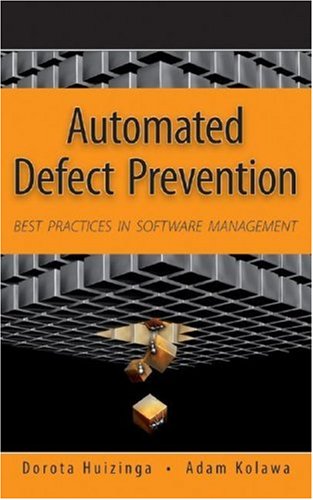Product desciption
Automated Defect Prevention Best Practices In Software Management Dorota Huizinga by Dorota Huizinga, Adam Kolawa 9780470042120, 0470042125 instant download after payment.
I've read this book from cover to cover. I've read many books on software development, software processes, best practices, qualitative approaches, and quantitative approaches, many from SEI. This book has to be one of the top two. For software professionals in leadership positions facing today's pressures of delivering quality software that meets customer expectations according to plan, this book is a must-read. You will be able to implement techniques directly into your organizational processes and deliverables with considerable ease. Kolawa and Huizinga have forged a grimoire that should be on every software leaders' desk, be they Project Managers, Software Architects, PMO Directors, of Vice Presidents of Development. Here are the key take-aways from this book: 1. Clarity: All concepts, practices, and examples were extraordinarily clear. There was never a question as to what was meant, or confusion in the information conveyed. 2. Readability: The text is very user-friendly. Coming from a very technical background, I tend to read challenging and complicated material. In this book, you were able to frame both technical and complex material in a readable way. In other words, I never had to re-read anything in the book. All of the material was very easy to understand. I feel the ability to effectively reduce complexity to simplicity is the hallmark of good authorship. 3. Implementable: I found the practice-side of the book to be what I call `out-of-the-box.' This means I was able to take material directly from the text and apply that into my process(es) or deliverables with very little work or trouble. (I actually did this multiple times.) This is a testament to the subtitle of the book, Best Practices in Software Management. 4. Usefulness: The book is actually aimed at being useful within for-profit businesses. Theoretical books are good for concepts, but it's up to the readers to find ways to translate the theory into executable practices (which often is beyond the role and responsibility of the readers). Your book actually bridges this gap, and provides mechanisms to help readers implement valuable techniques into their organizations, independent of their infrastructure. These four points make a huge difference for readers looking to improve their software development processes to ensure profitability, cost savings, and customer satisfaction. Producing quality software while building defect prevention into your processes is key in today's competitive software marketplace. With these techniques, your organization will continue to become better, managing, reducing, and even eliminating the traditional sources of defects in software deliverables. You won't be disappointed in buying this book, as you'll refer to over and over again as you build process improvement into your organization.


